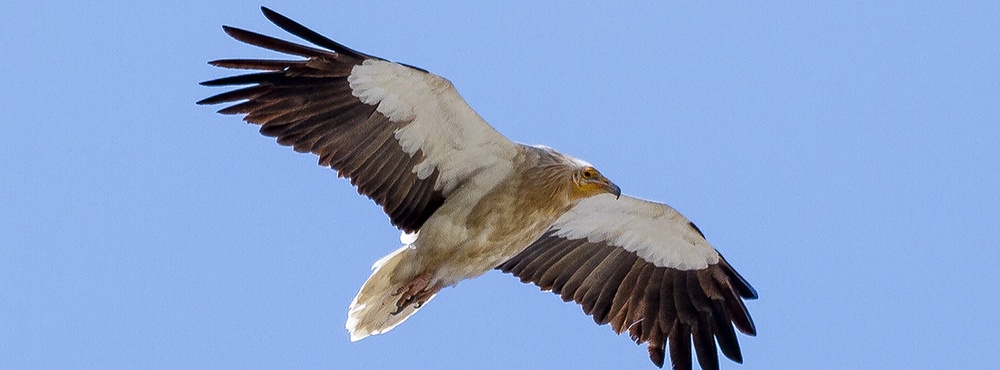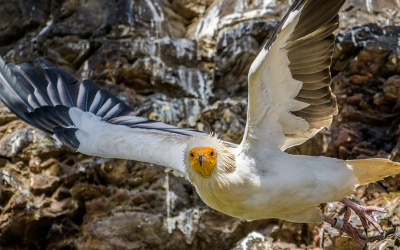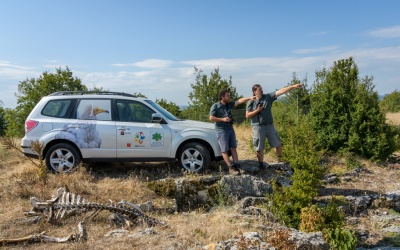Return to the Wild

Since 2013, Prague Zoo has been collaborating with conservation organisations in southern Europe, and since 2015, it has taken part in releasing captive-bred chicks back into the wild. The zoo has also contributed to research on release methods with the aim of ensuring the highest possible survival rate for young vultures.

Reintroduction of the Egyptian vulture in the Rhodope Mountains, southern Bulgaria
Photo: Miroslav Bobek, Prague Zoo
By the end of 2024, a total of 32 Egyptian vultures had been released into the wild in the Eastern Rhodope Mountains, Bulgaria, nine of which hatched in Prague. Many others were either transported there by Prague Zoo or had their transport organised by the zoo. In the same year, the first successful breeding was recorded among individuals released in previous years—a significant milestone in the recovery of the Bulgarian population of this species.
Young Egyptian vultures begin their autumn migration to African wintering grounds just a few weeks after hatching, covering a journey of several thousand kilometres. Many do not survive this arduous trip. At the start of the project, no established methodology existed for their release, so Prague Zoo also contributed to research on release techniques with the aim of ensuring the highest possible survival rate. Of the three methods tested, the delayed release technique proved to be the most successful.
With the delayed release method, young Egyptian vultures are not allowed to migrate south in their first year of life, but instead do so in their second year. They spend their first winter still under human care and are only transferred to a release aviary from the zoo or breeding centre in April of the following year. They remain there for at least a month before flying into the wild. This gives them the entire spring and summer season to acclimatise to the site and learn to obtain natural food. As all the vultures are fitted with tracking devices, we can monitor their movements and fates. Of the vultures released using this method, 75 % survived to the following season—an even higher survival rate than that of wild individuals.
The smallest of the five vulture species found in Europe, the Egyptian vulture is, together with the Rüppell’s vulture, also the most endangered of them. This is why Prague Zoo is pursuing and developing a project aimed at helping vultures in their southern European homeland.
| Focal species: Egyptian vulture (Neophron percnopterus) Where we help: Bulgaria (mainly the Eastern Rhodope Mountains) and other areas in southern Europe Project active since: 2013 |
 Vultures under threat
Vultures under threat
To a greater or lesser degree, vultures are threatened on every continent where they live, including Europe. The main causes are poisoning from agrochemicals, veterinary drugs, and toxic baits. Power lines also pose a serious threat.
 Breeding programme
Breeding programme
Prague Zoo ranks among the most successful breeders of the Egyptian vulture. Since 2002, it has kept the species’ studbook, and since 2012, it has coordinated its EAZA Ex-situ Programme (EEP), a population management and conservation programme under the auspices of the European Association of Zoos and Aquaria (EAZA).
 Return to the wild
Return to the wild
We take part in releasing captive-bred chicks back into the wild. We have also contributed to research on release methods designed to ensure the highest possible survival rate for young vultures.
 Other activities
Other activities
Prague Zoo provides financial support to the Bulgarian conservation organisation Green Balkans. Among other things, it has contributed to the construction of breeding aviaries and the establishment of a feeding site for the local wild vultures.
ZOOPRAHA.CZ
Contacts
- The Prague zoological garden
U Trojskeho zamku 120/3
171 00 Praha 7
Phone.: (+420) 296 112 230 (public relations department)
e-mail: zoopraha@zoopraha.cz
Others








